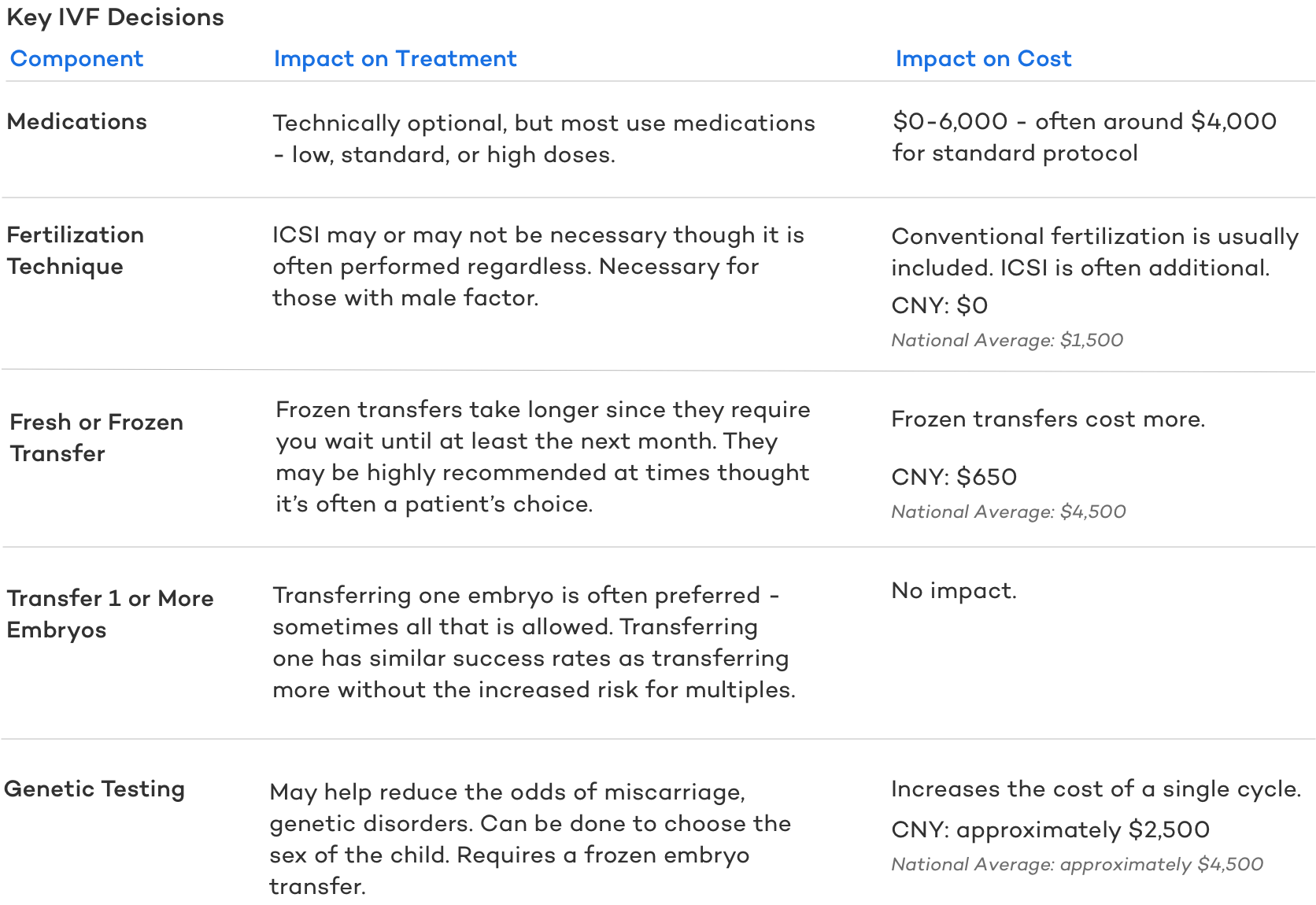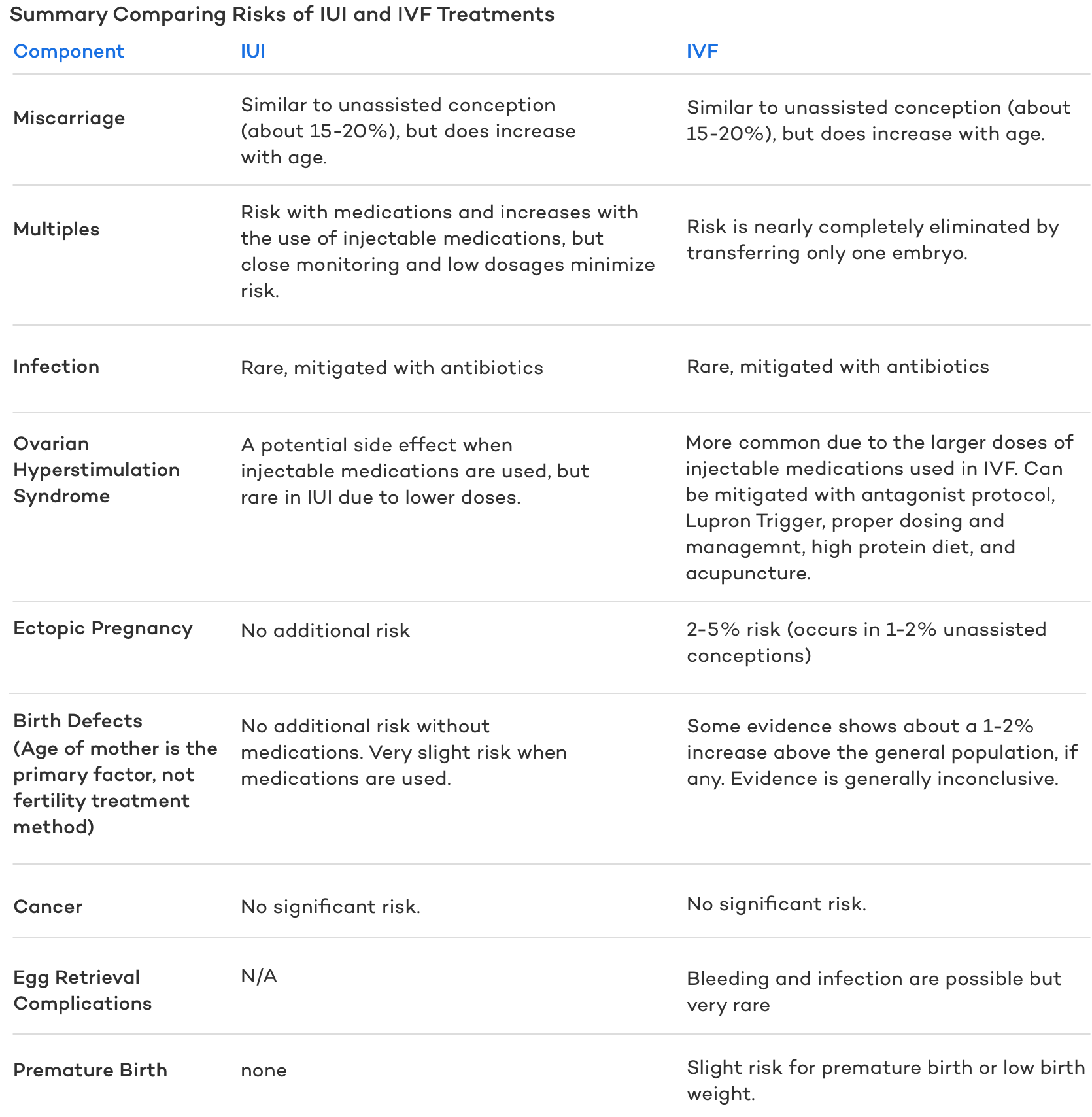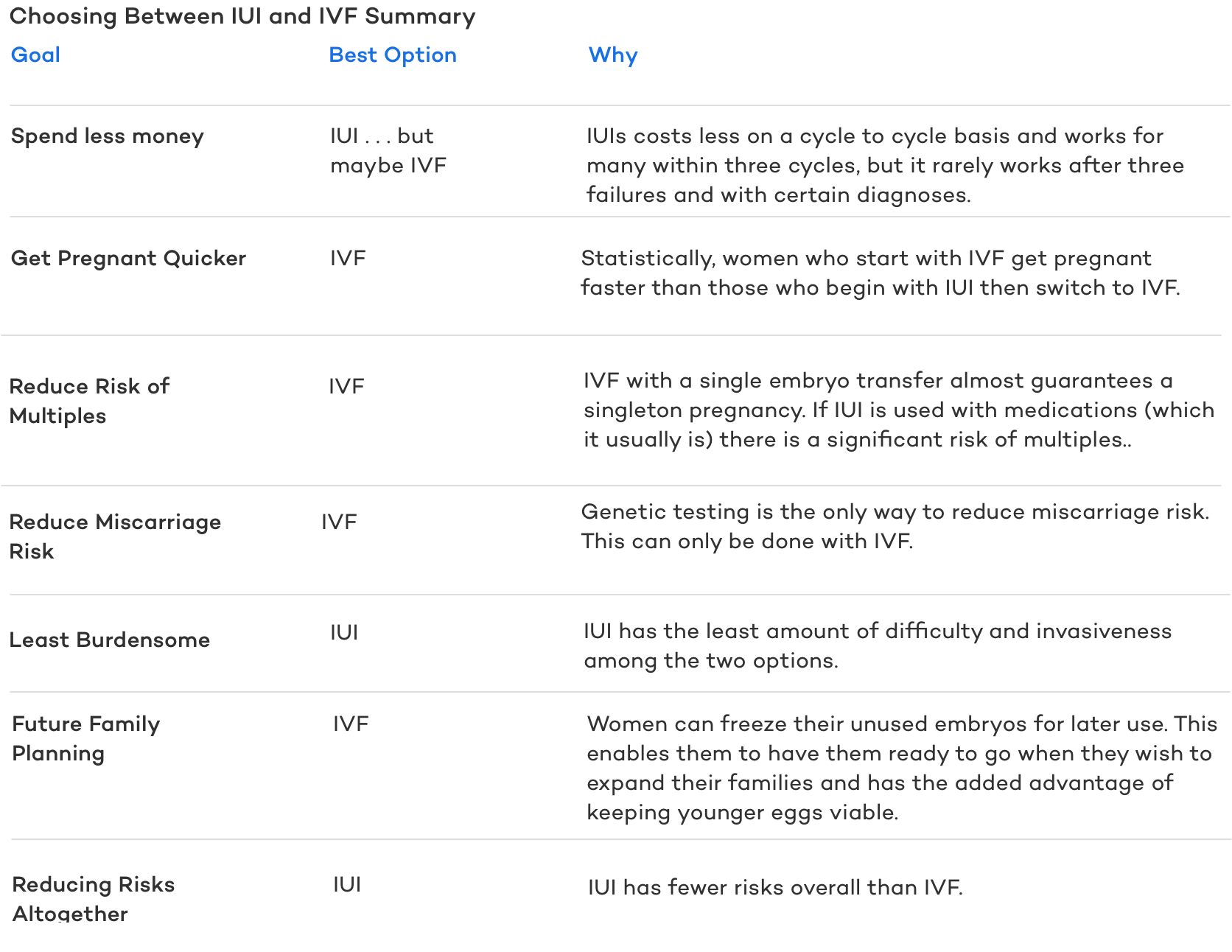IUI vs. IVF: Comparing the procedures, risks, benefits, costs, and success

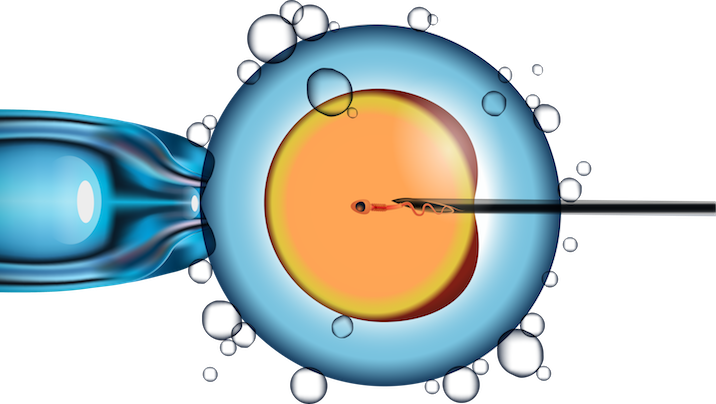
IUI or IVF? Now that is a good question. One of the first things people should do when exploring fertility treatment options is to compare intrauterine inseminations (IUI) and in vitro fertilization (IVF) as they are two of the most common and effective fertility treatments. But how do you know if IUI or IVF is the right treatment option for you?
While it’s always recommended to consult with a medical provider before making any treatment decisions, this article serves as a great jumping point for those looking to get pregnant using assisted reproductive technologies (ART). In it, we discuss everything you need to know about IUI and IVF. We start things off with a high-level overview, then jump into the different types of each treatment, discuss treatment details, key decisions within each treatment, success rates, cost comparisons, risks, and who each treatment might be a good fit for.
Let the battle of IUI vs. IVF begin!
IUI vs. IVF: The Fast Facts
The main difference between IUI and IVF is the number of eggs the female produced and the place of fertilization.
- With an IUI, a woman is only supposed to develop one or two eggs. Sperm are deposited within the uterus, which gives the sperm a head start but still requires natural fertilization to take place.
- In IVF, a woman is given more medications to develop lots of eggs. Ideally, they develop around 15 mature eggs. The eggs are removed from the ovaries, fertilized and developed in a lab for a number of days, and subsequently put back into the uterus as an early-stage embryo. While this may sound like a relatively minor difference, it leads to leads to a large number of noteworthy differences.
Treatment Process:
- IUI: An IUI can be done with no medications or a number of different medications to help develop and ovulate one or two eggs. Around day 14 of a woman’s cycle, the insemination takes place which deposits sperm inside the uterus. This greatly increases the number of sperm at the junction of the uterus and fallopian tubes, the distance they have to swim to meet the egg, and thus increases the chances of natural conception for many people.
- IVF: During IVF, medications are usually taken for around 10 days to grow a large number of eggs. Once many eggs have developed, a procedure takes place where the eggs are removed from the ovaries. The eggs are then fertilized outside of the body in a lab. After growing for a few days in the lab, an embryo is transferred back into the woman’s uterus.
How they beat infertility
- An IUI helps beat infertility in two primary ways.
- Egg quality and ovulation: Medications are given to help grow and ovulate one or two mature eggs (some women may not ovulate otherwise).
- Sperm Quality: An IUI puts sperm much closer to its target (the egg). IUI can increase the number of sperm that make it to the fallopian tube by 1000x.
- IVF beats infertility in MANY ways:
- Ovulation: eggs are retrieved before ovulation
- Tubal issues: eggs are removed from the ovaries and the embryos are put back directly into the uterus completely bypassing the tubes.
- Sperm: With ICSI – a technique that directly injects sperm into the egg, you literally only need one healthy sperm.
- Uterine: Numerous medications can be given to optimize uterine receptivity and the timing of an embryo transfer.
- Miscarriage: Both genetic testing and reproductive immunology can be used alongside IVF which may reduce the odds of miscarriage for some.
- Egg Quality and quantity: The large dosages of medications mature a large number of eggs, mature eggs, are high-quality eggs.
- Elective: IVF can also be used for elective reasons like sex selection.
Safety:
- Both procedures are safe, and the risks are minimal. Proper monitoring, medication choice and dosage, and general care greatly reduce the risks and side effects.
- IVF requires “surgery” under anesthesia, whereas an IUI does not.
General Treatment Order:
- IUI is less invasive, so if diagnosis allows, it is generally tried before proceeding to the more invasive IVF procedure.
- There are many diagnoses that are contraindicative of IUI. If a patient has blocked tubes, severe male factor infertility, or a number of other male or female factors, a fertility specialist may recommend jumping straight to in vitro fertilization as IVF works around substantially more infertility causing issues and an IUI.
Time to Pregnancy:
- IVF has a much faster time to pregnancy due to it’s higher success rate per cycle. For those under 35, success rates are generally around 50% per treatment.
- IUIs generally have a success rate of around 5-20% per cycle. If an IUI is to be successful it most often happens in the first three or four treatment cycles .
Cost:
- Costs range greatly for both an IUI and IVF and depend upon a number of factors.
- On a per cycle basis, IUI is significantly more affordable.
- On a per birth basis, the picture isn’t quite as clear. IUIs may be an incredibly poor option for some (like those with blocked tubes), making the odds of birth next to zero. Additionally, after three IUI cycles, the odds of any subsequent cycle working are low, and IVF becomes much more affordable on a per birth basis.
Types of IUI and IVF Treatments
Before we get much further, it’s important to discuss that there are many different types of IUI and IVF. While they belong to the same treatment “family,” there are important differences and variations that should be understood.
Types of IUI
There are a few different types of insemination based on where the semen is deposited and four different types of IUI cycles based on the medications used in the treatment. Your preferences, fertility diagnostic testing, and history help guide which type of IUI cycle is best for you.
Types of insemination based on where the sperm is deposited
There are two main types of artificial inseminations:
- IVI/ICI: An Intra(vaginal/cervical) Insemination is a treatment that can be done in a medical office or as an at-home insemination. With an IVI, sperm are deposited with a syringe at the top of the vagina as close to the cervix as possible. Technically a form of artificial insemination, NOT INTRAUTERINE INSEMINATION.
- IUI: An Intrauterine Insemination can only be done in a medical setting, either at an OBGYN office or Fertility Clinic. With an IUI, the sperm is “washed,” concentrated, and loaded into a catheter that is fed through the cervix and deposited near the top of the uterus.
Types of IUI based on the medication used
- Natural cycle – No medications are used for a natural IUI cycle.
- Trigger cycle – This adds the component of using medication to trigger ovulation for a specific time to more optimally time insemination, further increasing odds of pregnancy. IUI typically occurs 12-36 hours after the trigger medication has been taken orally or injected.
- Oral medication cycle – Clomid or letrozole is given to enhance egg development and ovulation. There’s also a lessened risk of multiples with oral medications compared to injectables.
- Injectable medication cycle – Injectable gonadotropin medications stimulate the ovaries further than oral medications can. This is why the risk of multiples is greater with injectables.
No matter what type of IUI cycle you choose, your cycle is monitored either with consistent blood work and ultrasounds or at home via an ovulation predictor kit. If your IUI cycle includes medications, you will likely be monitored with bloodwork and ultrasounds to ensure follicular development and a safe and effective cycle.
Types of IVF
The best way to view the different types of IVF is to understand that IVF is an umbrella term used to describe a procedure where fertilization happens outside of the body. Differences can be based on medications, fertilization, embryo “processing,” and where fertilization takes place. Various types can also be combined.
- Conventional IVF – Fertilization Technique: The first fertilization method developed. Sperm are placed in a petri dish to fertilize the egg via self-employed penetration into the egg.
- ICSI IVF – Fertilization Technique: IVF with a unique fertilization technique whereby sperm are loaded into a microneedle and injected directly into the egg.
- Mini IVF – Medication Protocol: IVF with a reduced medication protocol designed to recruit fewer, but hopefully still more than one quality egg.
- Natural IVF – Medication Protocol: An IVF cycle in which no medications are used to grow extra eggs. Can only retrieve one (or in a rare case two) eggs.
- FET IVF – Embryo Processing: The transfer of a previously frozen and thawed embryo from an IVF cycle.
- INVOcell – Fertilization Location: A fertilization alternative where sperm and egg are placed in a thumb-sized medical device and inserted into the vagina for fertilization and early development. Essential the same as conventional fertilization only inside a device placed in the vagina rather than an incubator in an embryology lab.
- Reciprocal IVF: Reciprocal IVF is an IVF variation used by lesbian women and trans men that allows both to be biologically connected to the baby. One partner’s eggs are used, the other partner carries the baby.
IUI vs. IVF Treatment Process
IUI Process:
An IUI procedure is the process of directly injecting sperm into the top of the uterus. This increases the odds of conception by reducing the distance the sperm must travel to meet the egg. That said, when most people talk about IUIs, they’re referring to the steps leading up to and after the actual procedure. An IUI treatment can be summarized into a few steps:
- IUI Preparation – Before your IUI procedure, men and women can make changes to their diet, add beneficial supplements or medications, and utilize holistic therapies like acupuncture and massage to ensure the best possible outcome from IUI. Taking this time to focus on improving the quality of your eggs pays off exponentially because it’s something you have the power to change. Best results are seen if adopted for 90 days prior to treatment.
- Egg Development – This step is either part of the woman’s natural egg development or stimulated with medications and lasts roughly 5-14 days. Once your follicles are optimal size, a trigger medication may be given to finalize egg maturation and trigger ovulation. This phase of egg development may or may not be accompanied by ultrasound and bloodwork monitoring.
- Insemination – This is done as close to the day of ovulation as possible. During insemination, washed and concentrated sperm is injected into the top of your uterus through a small catheter inserted through the vagina and cervix. Once injected, the catheter is removed. You can expect the insemination to take just a few minutes. It is possible to experience mild cramping post-procedure. The sperm used in your IUI can usually be collected at the office performing the IUI (preferred if possible), frozen and shipped to the center, collected fresh at your home and shipped to our centers using our sperm shipping kits (not advised), or ordered and sent to our office from a donor agency. Fresh semen samples are prepared in our laboratory to obtain a concentration of active sperm.
- Post Procedure – If the IUI is successful, a blood pregnancy test will be positive in two weeks. Once a heartbeat is detected via ultrasound, the pregnancy has a 90-95% probability of resulting in a live birth.
IVF Process:
Regardless of the type of IVF procedure you’re having, most can be simplified into a few key steps:
- Treatment Preparation – Similar to IUI, you can help give your fertility a boost by changing your diet, adding beneficial supplements or medications, enhancing your immune system, utilizing holistic therapies, and changing your lifestyle to ensure the best possible outcome from IVF.
- Ovarian stimulation – You’ll take stimulation medications to increases both the quantity and quality of eggs. This usually begins during days 2-4 of your cycle and continues for around ten days. You’ll be closely monitored during this time to track your uterine lining, follicular development, and hormone levels. Once the follicles are optimal size, a trigger medication is given to fully mature the eggs.
- Egg retrieval and sperm collection – Egg retrieval happens 35 hours after the trigger shot. It is done under light anesthesia and takes just 5-10 minutes. During retrieval, a tiny hollow needle is pierced through the vaginal wall towards an ovary. At this point, the fluid that contains the developed eggs is drained from the follicles and immediately taken to the IVF laboratory, where they will be fertilized and developed. Sperm is collected the same day as the procedure by ejaculation into a sterile specimen container, frozen ahead of time, via a donor, or through more advanced sperm retrieval procedures. Next, the sperm is washed, placed in a solution similar to the fallopian tubes, and used for fertilization.
- The laboratory – This is when the harvested eggs are fertilized by an embryologist. Once fertilized, they’re grown 3-5 days until they’re able to be transferred into the woman’s uterus. Prior to the transfer, the embryos can be genetically tested. Although testing isn’t right for everyone, it’s useful for some people as it may help prevent miscarriage, passing on known genetic disorders, and can also be used to choose the sex of the child.
- Embryo transfer – At this point, 1-2 embryos are gently placed into the woman’s uterus through a small catheter. Any unused embryos can be frozen for future use.
- Post transfer – You’ll likely take progesterone and estrogen to improve implantation and pregnancy rates. If the transfer is successful, a blood pregnancy test will be positive in 10-14 days. From there, ultrasounds are used to ensure the implantation site as well as check for a heartbeat. The good news is that once a heartbeat is detected, the pregnancy has a 90-95% probability of the pregnancy resulting in a live birth.
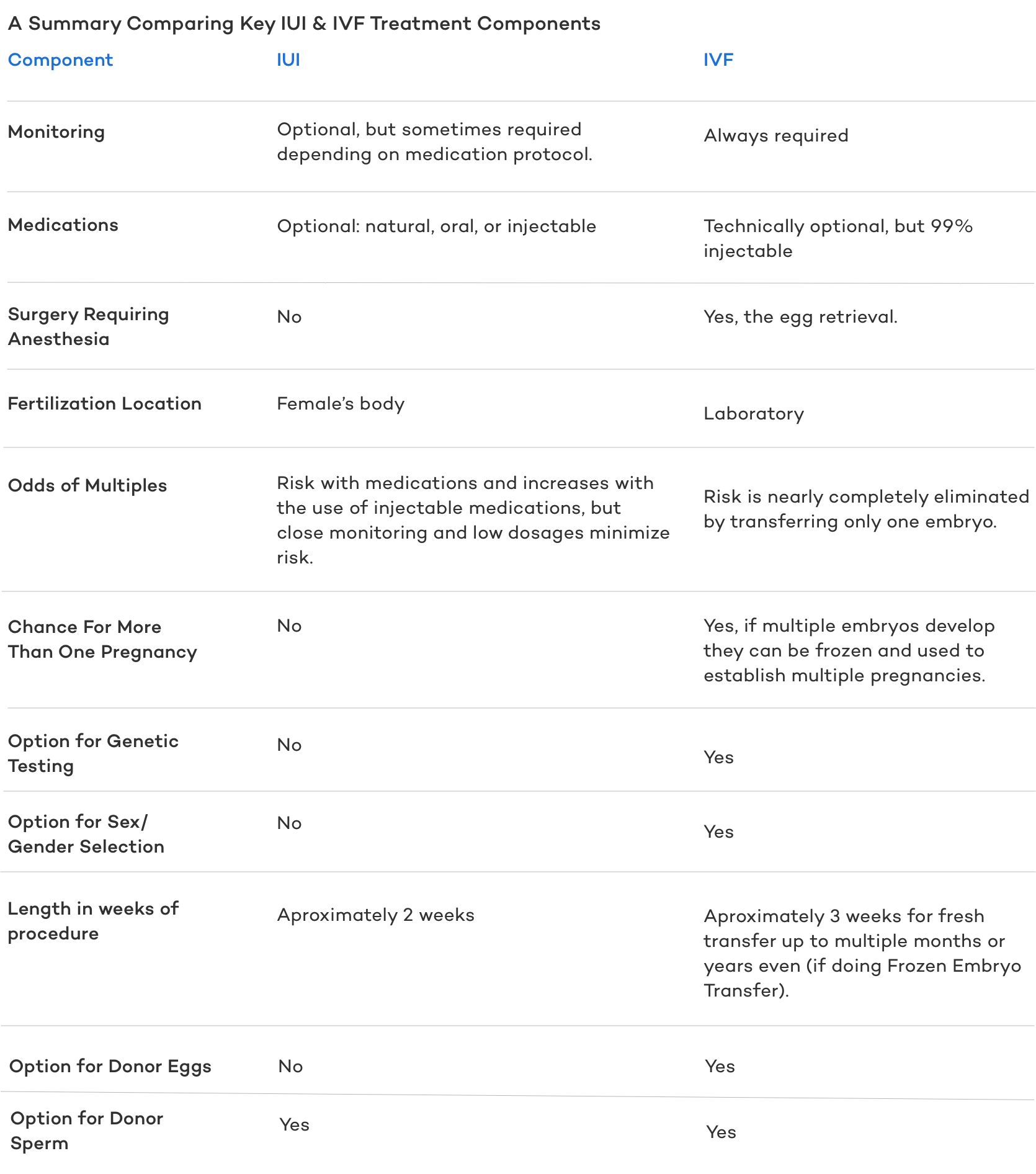
Key Decisions In IUI and IVF Treatment
No matter what treatment you choose, IUI or IVF, there will be many key decisions that have to be made by you and your healthcare provider. Let’s take a look at what some of those key decisions are for both IUI and IVF.
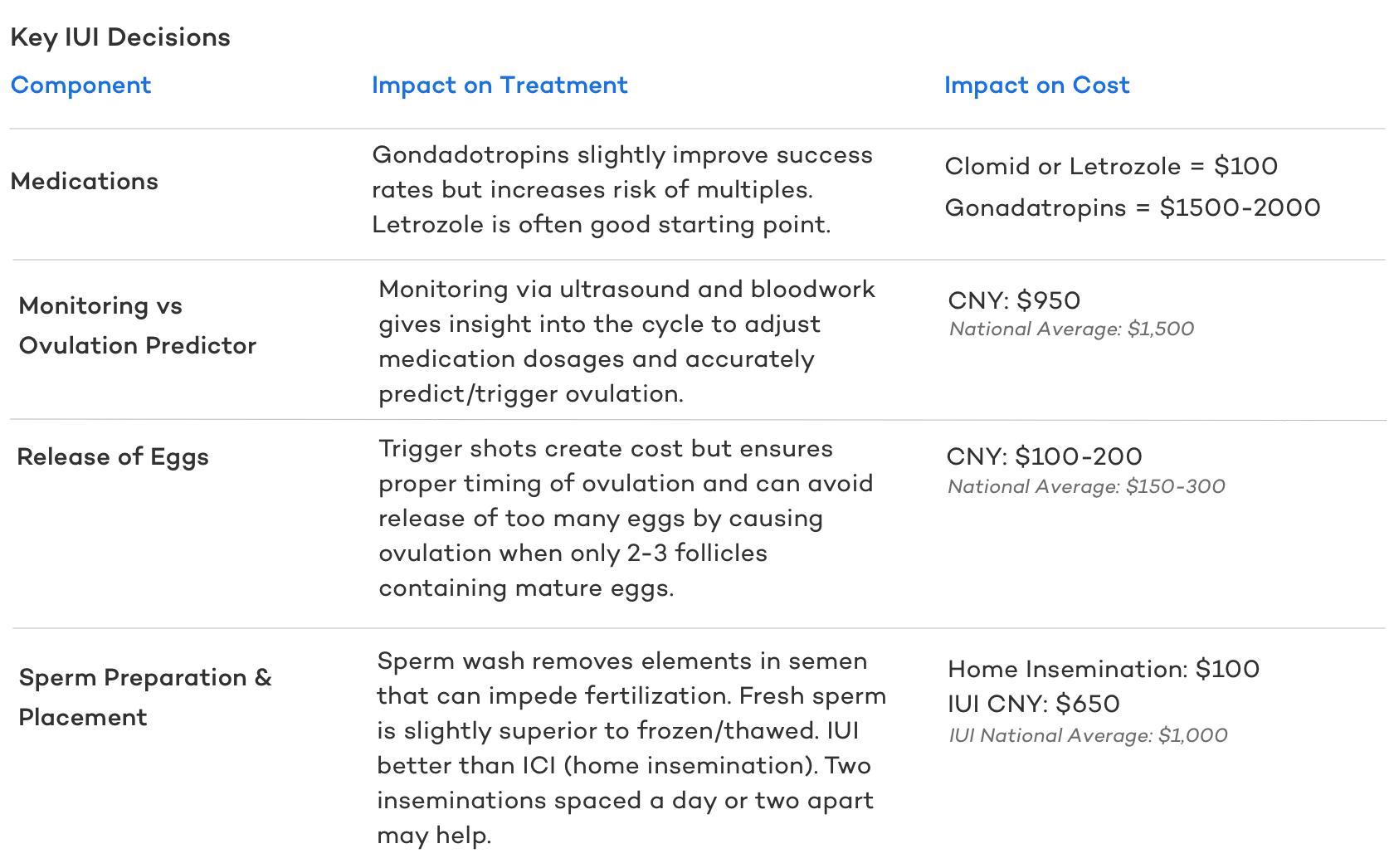
IUI vs. IVF – Success Rate
Women who switch from IUI to IVF sooner or begin with IVF get pregnant quicker than those who stick or start with IUI. One study found that undergoing immediate IVF resulted in superior pregnancy rates with fewer treatment cycles compared to those who did two rounds of IUI before switching to IVF. While the immediate IVF group got pregnant quicker, the overall success after up to 6 IVF cycles was similar.
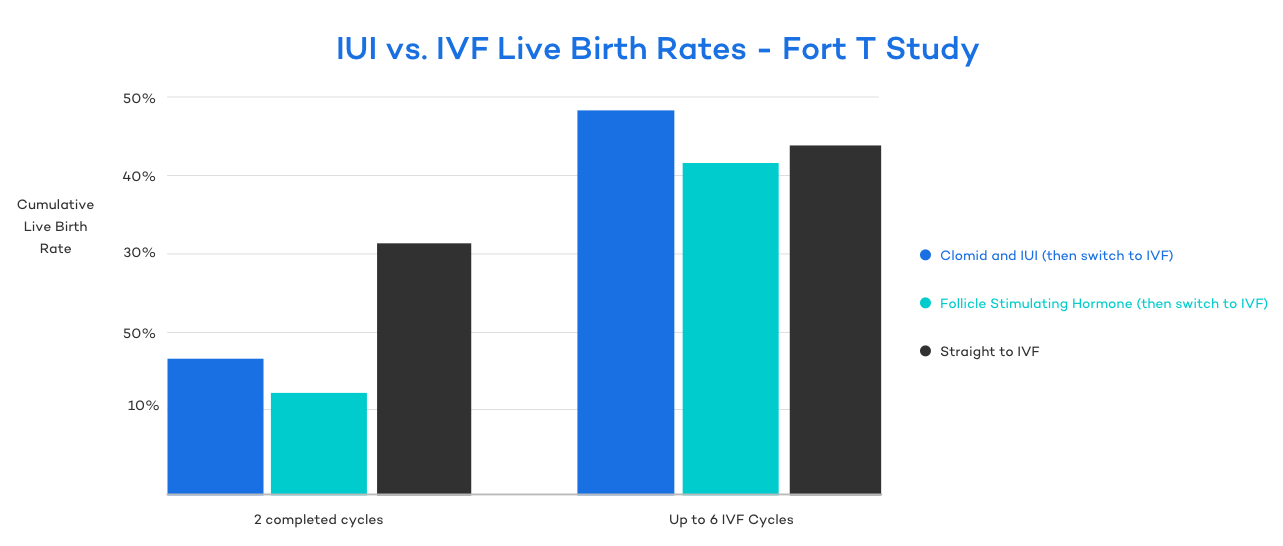
IUIs are only successful for some populations and generally tend not to work after a history of a few failed IUIs. IUI success is dependent upon many variables such as age, reasons for infertility, and medications used.
As a whole, IUI has lower pregnancy rates than IVF, with odds topping out around 15-20% for ideal candidates.
While the odds of IVF success vary greatly by many things, including age, sperm and egg quality, reasons for infertility, and clinic, ideal candidates have odds in the 50-60% range [3]. Of course, based on factors just mentioned (and others), one’s odds could be both much higher or much lower.
IUI vs. IVF Cost
At CNY Fertility, we pride ourselves on offering affordable, top-notch fertility care for those wishing to start or expand their families. For this reason, we keep our costs well below the national average. We live and breathe by our motto: Making Priceless Affordable.
The cost of an IUI is almost certainly less on a per cycle basis, but because IVF has much higher success rates and IUI is a poor option for some, the higher per cycle cost of IVF can actually be more affordable in the long run – in terms of the cost to bring home a baby. Because most successful IUIs happen in the first three or four-cycle, it eventually becomes very expensive to bring home a baby with an IUI.
For many people seeking fertility care, the cost can be an issue. Currently, only 18 states have fertility insurance coverage laws, forcing many people to turn to financing options to pay for their fertility treatments. In addition, there are many grants, and some clinics even offer guarantee programs.
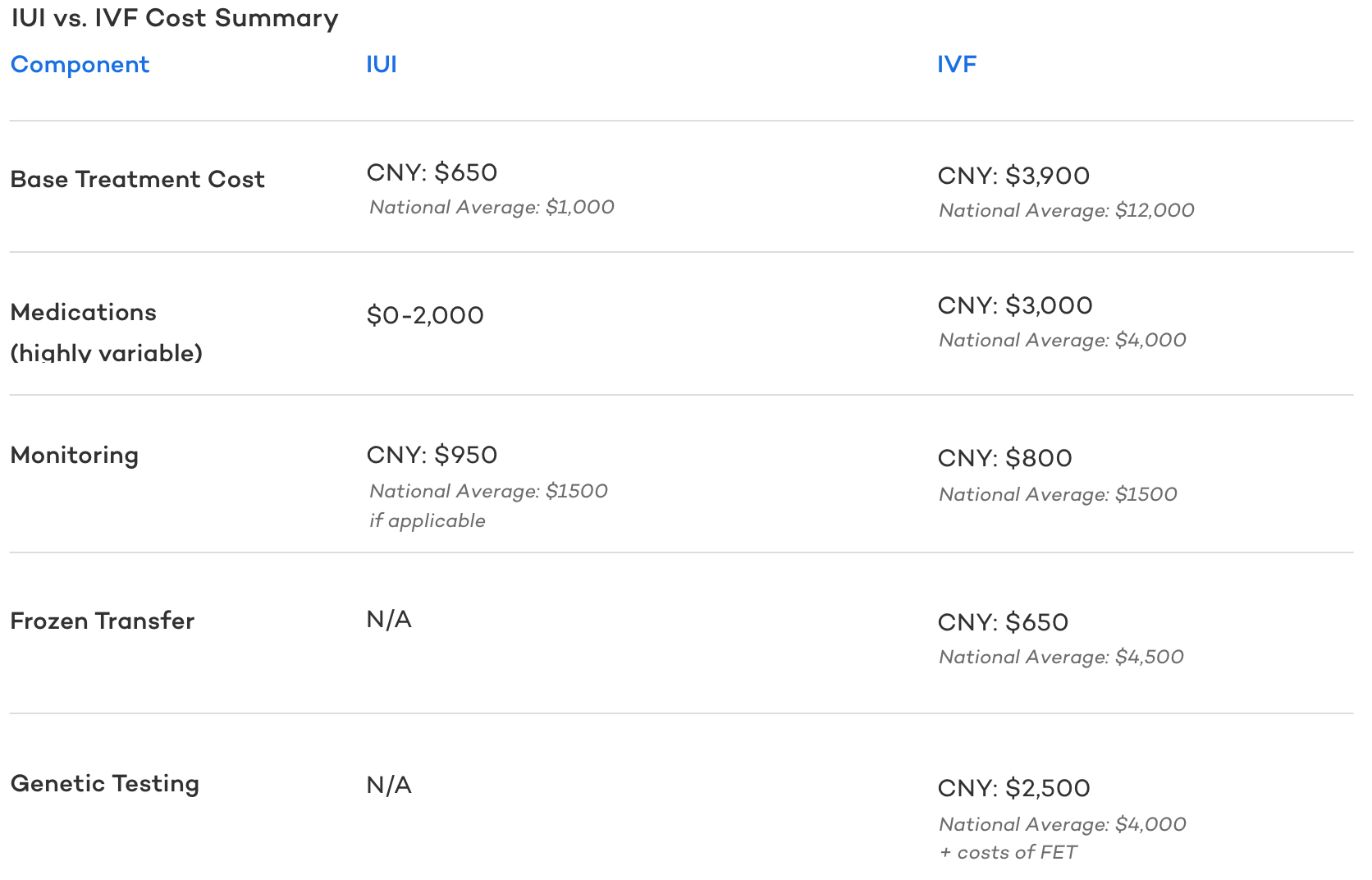
If you have any questions about CNY Fertility pricing, our guarantee, or what financing options are available to you, check out our webpage on Affording Fertility Treatment.
IUI vs. IVF Risks
As with any medical procedure, there are some risks to keep in mind. When choosing between IUI and IVF, the risk is certainly something to consider. The chances of experiencing either a miscarriage or multiples are concerns many have when deciding to undergo fertility treatments. So let’s take a look at the odds of either of these things occurring, plus a few other risks to be aware of.
IUI and IVF Side Effects
- Medication-induced side effects
- Hot flashes
- Bloating
- Mood swings or depression
- Ovarian cysts
- Swollen, painful ovaries (OHSS)
- Breast tenderness
Deciding between IUI vs. IVF: Who is the best candidate for each
IUI and IVF have the same end goal in mind – pregnancy. But the methods to get there are a bit different. In addition, whether or not IUI or IVF is right for you is based on a few key factors.
IUI may be a good fit for those with the following circumstances:
- Ovulatory factor infertility – those with no or irregular periods, PCOS
- Male factor infertility (mild)
- Ejaculation dysfunction
- Cervical factor infertility
- Sperm allergy
- Single and lesbian women with needing donor sperm
- Unexplained infertility
IUI may NOT a good fit for those who:
- Moderate to severe endometriosis or other uterine abnormalities
- Blocked fallopian tubes
- History of pelvic infections
- Those with poor results from a semen analysis
- Those with good results from a semen analysis who have been trying to conceive for a long time
IVF may be a better fit for those with the following circumstances:
- Fallopian tube damage or blockage
- History of tubal ligation – can also consider a tubal ligation reversal.
- Semen abnormalities
- Genetic disorders
- Those looking to choose the sex of their child
- For women whose age or ovarian reserve may be a concern
- Lesbian women looking to both be involved in the creation of their child via reciprocal IVF
- Uterine fibroids
- Endometriosis
- Unexplained infertility (yes . . . this was listed under IUI as well)
IUI and IVF at CNY Fertility
When it comes to fertility care, you deserve only the best. At CNY Fertility, we empathize with you and understand how stressful it is to be dealing with infertility. That’s why we never treat our patients as numbers or nameless visitors. From the moment you enter our doors, you’ll be welcomed by our friendly staff and receive only high-quality, personalized care. We believe that fertility treatments aren’t a luxury reserved for a select few – It’s a human right that you wholeheartedly deserve, no matter your history or situation.
You’ll be pleased to know that the team at CNY Fertility is comprised of over 250 years of combined provider experience. When you choose us for your fertility needs, you can rest assured that you’ll be saying goodbye to cookie-cutter fertility care and saying hello to the superior, patient-centered care you deserve.
Click here to schedule your office or phone consultation to see how you can use IUI, IVF, or one of our many other services to start or expand your family. We are here for you and are ready to help you build the family you’ve been dreaming about.
References:
- https://www.fertstert.org/article/S0015-0282(14)00253-2/fulltext (FORT-T study)
- https://americanpregnancy.org/getting-pregnant/intrauterine-insemination/
- https://www.cdc.gov/art/artdata/index.html
- https://www.mayoclinic.org/tests-procedures/in-vitro-fertilization/about/pac-20384716?page=0&citems=10
- https://www.mayoclinic.org/tests-procedures/intrauterine-insemination/about/pac-20384722


